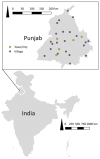Stray Dogs and Public Health: Population Estimation in Punjab, India
- PMID: 35202328
- PMCID: PMC8878280
- DOI: 10.3390/vetsci9020075
Stray Dogs and Public Health: Population Estimation in Punjab, India
Abstract
The overpopulation of stray dogs is a serious public health and animal welfare concern in India. Neglected zoonotic diseases such as rabies and echinococcosis are transmitted at the stray-dog human interface, particularly in low to middle-income countries. The current study was designed to estimate the stray dog populations in Punjab to enhance the implementation of animal birth and disease (for example, rabies vaccination) control programs. This is the first systematic estimation of the stray dog population using a recommended method (mark-re-sight) in Punjab, India. The study was conducted from August 2016 to November 2017 in selected villages or wards in Punjab. For the rural areas, 22 sub-districts in each district were randomly selected, then one village from each of the 22 selected sub-districts was selected (by convenience sampling). For urban areas, 3 towns (less than 100,000 human population) and 2 large cities (more than or equal to 100,000 human population) were randomly selected, followed by convenience selection of two wards from each of the 5 selected towns/cities. To estimate the dog population size, we used a modified mark-re-sight procedure and analysed counts using two methods; the Lincoln-Petersen formula with Chapman's correction, and an application of Good-Turing theory (SuperDuplicates method; estimated per km2 and per 1000 adult humans and were compared between localities (villages vs. towns), dog sex (male vs. female) and age group (young vs. adult) using linear mixed models with district as a random effect. The predicted mean (95% CI) count of the dogs per village or ward were extrapolated to estimate the number of stray dogs in Punjab based on (a) the number of villages and wards in the state; (b) the adult human population of the state and (c) the built-up area of the state. Median stray dog populations per village and per ward using the Lincoln-Petersen formula with Chapman's correction were estimated to be 33 and 65 dogs, respectively. Higher estimates of 61 per village and 112 per ward are reported using the SuperDuplicates method. The number of males was significantly higher than the number of females and the number of adult dogs was about three times the number of young dogs. Based on different methods, estimates of the mean stray dog population in the state of Punjab ranged from 519,000 to 1,569,000. The current study revealed that there are a substantial number of stray dogs and a high number reside in rural (versus urban) areas in Punjab. The estimated stray dog numbers pose a potential public health hazard in Punjab. This impact requires assessment. The estimated stray dog numbers will help develop a dog population and rabies control program in which information about the logistics required as well as costs of implementing such programmes in Punjab can be incorporated.
Keywords: India; Punjab; public health; roaming-dog; stray dog count.
Conflict of interest statement
The authors declare no conflict of interest.
Figures

References
-
- Larson G., Karlsson E.K., Perri A., Webster M.T., Ho S.Y., Peters J., Stahl P.W., Piper P.J., Lingaas F., Fredholm M., et al. Rethinking dog domestication by integrating genetics, archeology and biogeography. Proc. Natl. Acad. Sci. USA. 2012;109:8878–8883. doi: 10.1073/pnas.1203005109. - DOI - PMC - PubMed
-
- Headey B., Krause P. Health benefits and potential budget savings due to pets. Australian and German survey results. Aust. Soc. Monit. 1999;2:4–6.
LinkOut - more resources
Full Text Sources

